All tutorial examples in the Chess Academy Tutorial & Training program are divided into several tutorial modules and arranged according to topics and subtopics. These examples are mostly commented on in detail with texts and variations and in each critical key position, there is a possibility to find the best solution in such position by yourself.
All comments on the current position are displayed in the comment window. Text comments and special chess characters can be displayed here. If the space of the window is not sufficient for displaying the entire comment, a scroll bar appears at the right edge of the window.
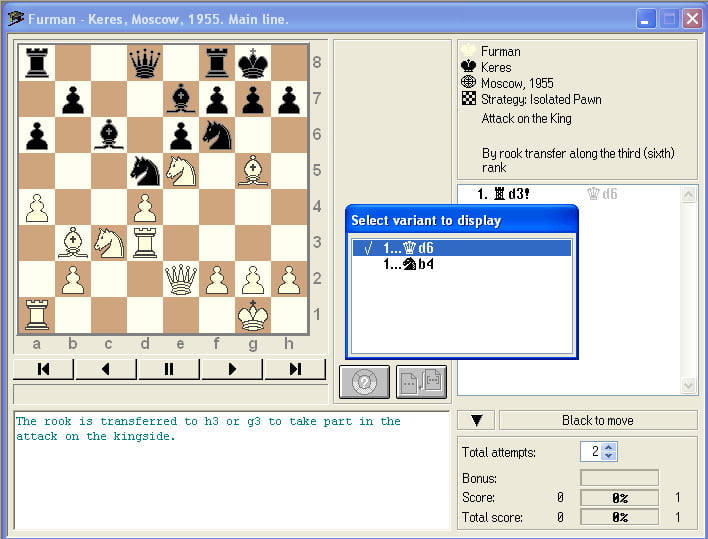
Variants that are displayed in the comment window can also be replayed on the “Variant board”. Even if there are further sub-variants in a variant, these can be viewed on the variant board.
The menu of moves-candidates allows you to pass from variant to the subvariant(s), and from the main line to multiple variants as well.
To display controlled squares, enable the Analyse board first,
then choose the command Squares Control from the Game menu (or from the Example menu if you call this function from the tutorial program)
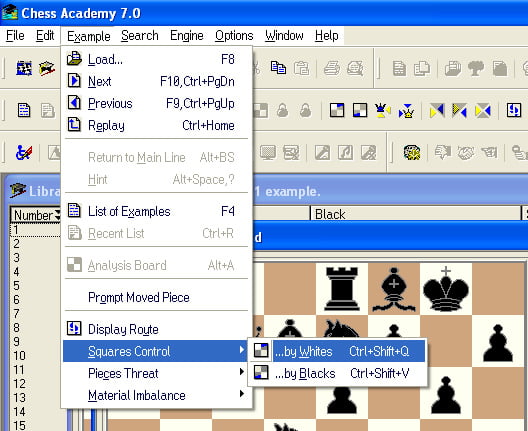
There you can choose between:
…by Whites (or click the toolbar button ![]() ).
).
Alternatively: use the keyboard shortcut Ctrl+Shift+Q
…by Blacks (or click the toolbar button ![]() ).
).
Alternatively: use keyboard shortcut Ctrl+Shift+V.
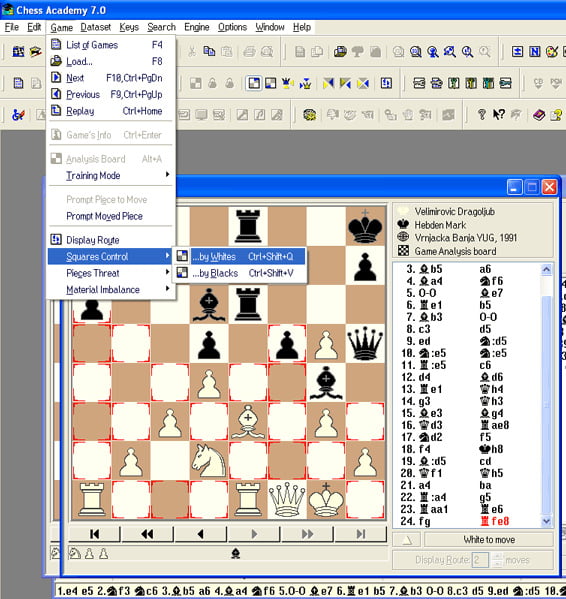
Please note: After double-clicking on a figure, all fields controlled by that figure will be displayed. After that, you can hold down the Ctrl key and double-click on another figure of the same color to additionally display all fields controlled by that figure. If you click on an opponent’s figure or release the Ctrl key, all field markings disappear.

This option remains switched on as long as you replay the game on the analysis board. To switch it off again, simply repeat the command or switch on another analysis function (for example: “Controlled figures”, “Material balance” or “Figure path”).
Please note: These functions are only possible on two-dimensional chessboards.
To display “controlled pieces”, first open the Analysis board.
Then select Pieces Threat from the Game menu (or from the Example menu if you access this function from the tutorial program).
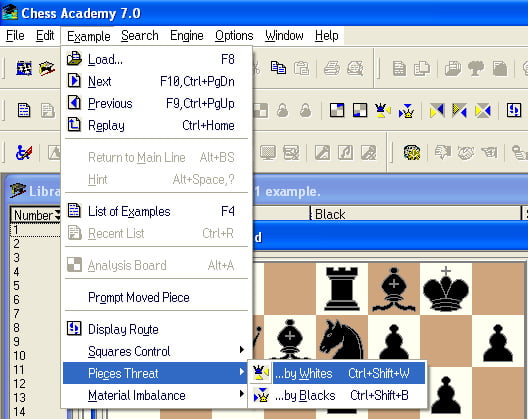
There you can choose between:
- … by Whites (alternatively, click on the icon
 or use the keyboard shortcut Ctrl+Shift+W)
or use the keyboard shortcut Ctrl+Shift+W) - … by Blacks (alternatively, click on the icon
 or use the keyboard shortcut Ctrl+Shift+B).
or use the keyboard shortcut Ctrl+Shift+B).

This option remains on as long as you replay the game on the analysis board. To switch it off again, simply repeat the command or switch on another analysis function (for example: “Controlled squares”, “Material balance” or “Figure path”).
Please note: These functions are only possible on two-dimensional chessboards.
To display material imbalance/balance, open the “Game Analysis” board and choose the Material Imbalance command from the Game menu (or from the Example menu when running the Tutorial program).

and select from:
… for Whites (alternatively: click the toolbar button ![]() )
)
… for Blacks (alternatively: click the toolbar button ![]() )
)
… for both (alternatively: click the toolbar button ![]() )
)
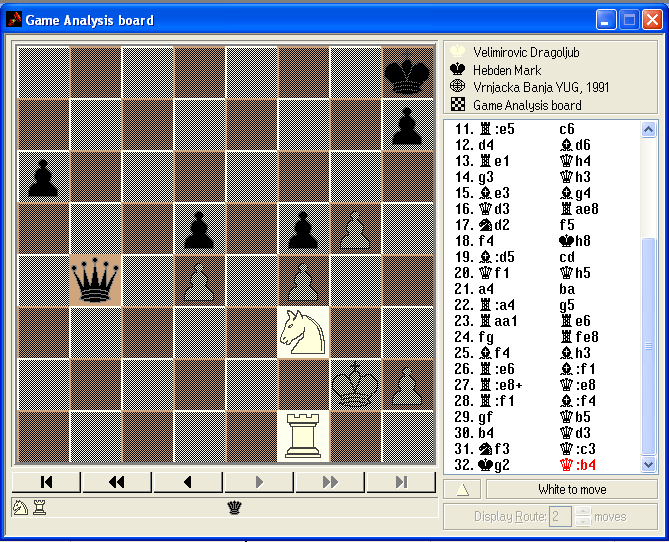
On these commands, all squares of the Analyse board are darkened except those responsible for material imbalance. If the current position is materially balanced, no differences appear on the board. By repeating the corresponding ‘Material Imbalance’ command, you can return the board to its normal state. Unlike the commands ‘Pieces threat’ and ‘Squares Control’, all other commands that change the position on the board (e.g., ‘Next move’) or display further information on the board (e.g. ‘Pieces threat’) switch off the display of the material imbalance.
Note: These commands are enabled for two-dimensional chess boards only.
This option displays on-board the moves of the selected piece or pawn that were made before the current position appears.

To do so, choose the command Display Route from the Game menu (or from the Example menu when running the Tutorial program).
Alternatively: click the toolbar button ![]() .
.
The mouse cursor will get a pointer-like shape.

Then you can point the necessary piece with the mouse cursor, and the piece’s route appears on the board. You have to repeat the command and return the mouse cursor to its normal shape if you want to make moves on the board. It is also possible to set the number of moves in the route (its ‘length’) you want to be displayed (from 1 to 99). The default value is 2 (i.e., only two last moves are displayed).
Please note: This function works only on two-dimensional chess boards.
While working with learning examples, the desire to replay individual variants on a board will often arise. Just playing those moves on the chessboard would include variants to the main line of an existing game. Sometimes you do not want to add anything, but to replay those moves only. For this reason, the “Analyse board” window is activated. This enables you to analyze the current position and enter possible variants on how to prolong the game. In this mode you can play whatever you like, Chess Academy temporarily records your actions but does not save them after closing the “Analyse board” window and returning to the main line.
When running Chess Academy Professional Database select Analysis Board from the Game menu, or click the toolbar button ![]() .
.
![]() Keyboard: Alt+A.
Keyboard: Alt+A.

The program displays a “Game analysis board” window.

In the Chess Academy Tutorial Program, select Analysis Board from the Examples menu, or click the button ![]() .
.

The program shows an “Example analysis board” window.
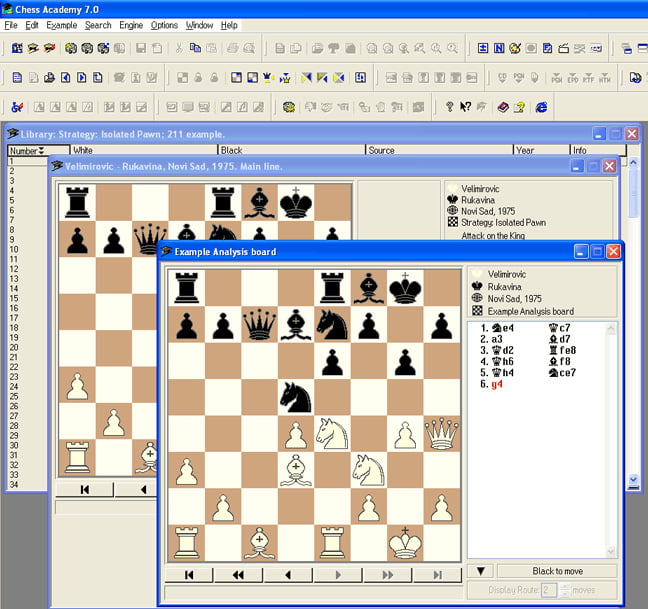
Only when the analysis board is enabled, the following commands are available:
- Displaying Controlled Pieces
- Displaying Controlled Squares
- Displaying Material Imbalance
- Displaying Piece’s Route
Please note: Due to the variety of options that require internal drawing on the chessboard, the “analysis board” is essentially only two-dimensional.
Select New Example from the Edit menu, or click the toolbar button ![]() to enter a new example.
to enter a new example.
![]() Alternatively press Ctrl+N
Alternatively press Ctrl+N

After selecting this option, the program will show the “Input Example’s Header” window.
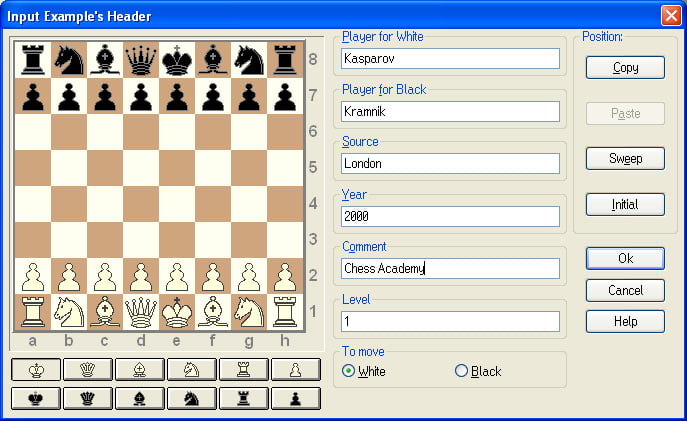
In the dialog box that appears, enter the requested information:
- The name of the user library – Select an existing user library in which the new example to be created is to be included. If you want to create a completely new library or if you have not yet created a user library, click New…. (see: Creating a New User’s Library).
- Player for White – enter here the name of the player for White.
- Player for Black – enter here the name of the player for Black.
- Source – Enter here the place where the tournament or competition was played.
Please note: The first letters in the Player and Source fields are always automatically capitalized by the program!
- Year – Enter here the year or years in which the game was played.
Please note: Unlike in the database program, you can specify any conceivable year in the tutorial program. So also a period of time. For example, you can therefore also enter “1996-99” or “1996-1999” as the date for a remote game.
- Comment – you may enter a short comment;
- To move – indicate a move turn from the entered start position on the board.
After entering a header please set up the start position and move turn. As a starting position you can also select the initial position of the game, it goes immediately by clicking on the Initial button in this window.
Click the Sweep button, and all pieces are automatically removed and the board is displayed empty.
Clicking the Copy button copies the current position to the clipboard.
By clicking on the Paste button the previously saved position will be displayed on the board (if previously saved, otherwise the clipboard will be empty and no position will be pasted as well).
If you make invalid entries, the program will notify you with a warning and an error message.
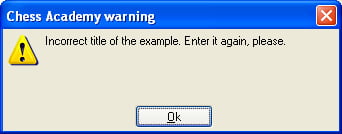
The following error messages may be displayed:
1. “Wrong header of the example. Please enter again”. This error message means that the name of the white player has either been left blank or the names of white and black are not accepted.
Please note: The first letters in the Player and Source fields are always automatically capitalized by the program!
2. “I cannot assign the year of the game. Please correct your input.” Only entries between 1 and 4096 are allowed.
Please note: Unlike in the database program, you can enter any conceivable year in the tutorial program. So also a period of time. For example, you can therefore enter “1994-99” or “1994-1999” as the date for a remote game.
3. “Cannot recognize the name of the user library. Please enter again.” This error message may have occurred because you entered no name or an incorrect name for the user library. You do not need to enter the file extender. The program will add it automatically if it is missing.
4. “Wrong initial position (or wrong move) was defined. Please specify again.” The initial position is impossible. Possible causes: For example, there may be two kings for one color on the board, or the party on the move may be in check.
If you want to cancel the input, use the Close command from the context menu of the window (right-click in the title bar). Alternatively, you can press Esc or Alt-F4. Press OK to get to the “Enter new tutorial example” window. Alternatively, you can press the Enter key.
If you have entered all entries correctly, you can now enter the game, variants, text comments, chess special characters, etc. in the “Enter new tutorial example” window.

In the text window below the board, you can enter any text comments and chess special characters. You get to this window by clicking once in this window with the left mouse button. If the text of your comment requires more lines than are visibly available, a scroll bar appears at the right edge of the window and the window scrolls down so that you have more space available.

If you want to cancel the input, use the Close command from the context menu of the window.
It is possible to print several tutorial examples directly from the selection list (see: Working with an Examples List).
To do this, select the Print command from the File menu or click on the toolbar button ![]() with the mouse.
with the mouse.
![]() Alternatively, you can use the keyboard shortcut Ctrl+P.
Alternatively, you can use the keyboard shortcut Ctrl+P.
Chess Academy will print the selected examples. All information, including variants, comments, and special symbols, will be printed. Comments and comment symbols are printed after the corresponding moves and are therefore suitable for judgments of the position. For more details on print options see the Printing Games and Keys chapter.
